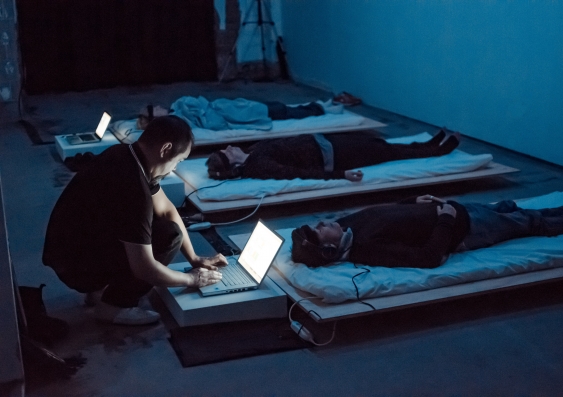The Big Anxiety Project at Vivid
UNSW researchers are merging art and technology in an interactive event for the Vivid Festival that aims to better understand what causes anxiety.
UNSW researchers are merging art and technology in an interactive event for the Vivid Festival that aims to better understand what causes anxiety.

Fran Strachan
Communications Manager Low Carbon Living CRC
+61 2 9385 5402
fran.strachan@unsw.edu.au
UNSW researchers are merging art and technology in an interactive event for the Vivid Festival that aims to better understand what causes anxiety.
Innovation and creativity are known to alleviate sickness and sorrow so it makes sense to bring these potent forces together to combat one of the most common health conditions in Australia today.
Anxiety is pervasive, we know that, but just how anxious are we as individuals and as a society? Are the stresses and strains of living and working in the city impacting our health; does online connectivity make us more or less anxious; where do we feel most comfortable or most at risk?
These are questions to be explored by a team of UNSW arts and mental health experts joining host Julie McCrossin at the Big Anxiety Project – an interactive Vivid Ideas event (at the Museum of Contemporary Art on 5 June) – that explores our experiences with anxiety.
“We want to find out more about how it feels, how we manage it, what might reduce it,” says Jill Bennett, Director of UNSW’s National Institute for Experimental Arts (NIEA) at UNSW Art & Design.
Professor Bennett is founder of The Big Anxiety Project with Professor Katherine Boydell from the BlackDog Institute.
It’s “a kind of innovative citizen science project” in which participants share their ideas and techniques for managing anxiety while enabling data to be collected along the way, Bennett says.
There's great potential for creative and evocative forms of art to illuminate the worlds we wish to understand better.
The project will bring art, technology and research together in the investigation of a condition which affects, on average, one in four people at some stage of their life.
“It’s not the kind of data that our colleagues in mental health would usually go after, but we wanted to build up a picture of the diverse range of anxiety experiences that people have as kids and teenagers, and across the lifespan, looking at different triggers and pressures that cause anxiety,” says Bennett.
Live online surveys and social media feeds will be used to generate info-graphics in real time that help visualise what anxiety feels like for different people. NIEA and Black Dog researchers will use algorithms to extract data from the surveys and feeds (using #anxietyfeelslike and following Twitter @thebiganxiety).
Dr George Khut from UNSW Art & Design will present his award-winning projects that use bio-feedback to design methods of stress reduction. Autistic artist, Dr Dawn Joy Leong, who recently completed a PhD with Bennett, is another speaker at Vivid. She uses creative techniques to explore the experience of anxiety and to create more relaxing spaces for people with autism.
"There's great potential for creative and evocative forms of art to illuminate the worlds we wish to understand better," explains Katherine Boydell, Professor of Mental Health at the Black Dog Institute. She is studying the use of art genres in the design, analysis, interpretation and communication of research results. She examines the ways in which the arts elicit and portray essential research findings and promote useable knowledge and understanding.
The collection of research for The Big Anxiety Project – which begins with Vivid – will culminate in The Anxiety Festival in 2017. Bennett anticipates that the meeting of artists, designers, creative thinkers, mental health experts and the wider community through forums such as these will bring about a framework for ideas and solutions.
“What we aim to do in the coming year is to generate some findings which may well be surprising and insightful for those in mental health research. Artists bring to this process a capacity to tell stories and to develop imagery that really might have an impact and can actually draw new insight out of the data. Artists are often very good at interpreting emotional stories and noticing things that, perhaps, those on the science side don’t see or don’t investigate,” says Bennett.
“This could be the start of something big.”